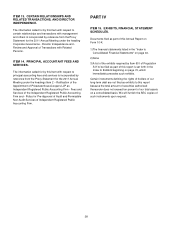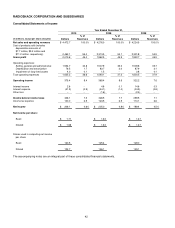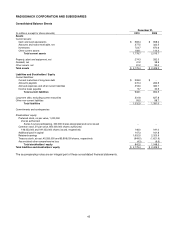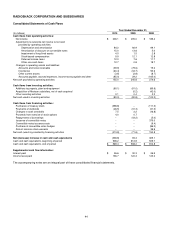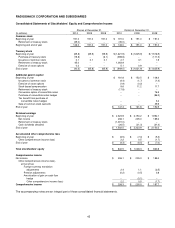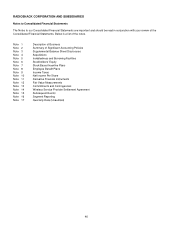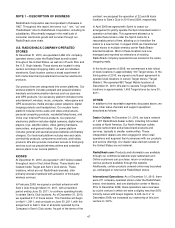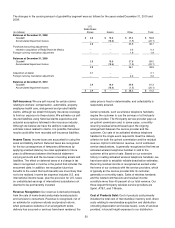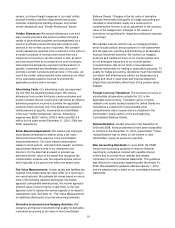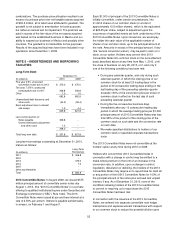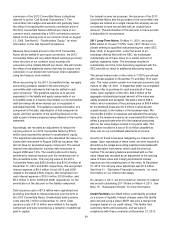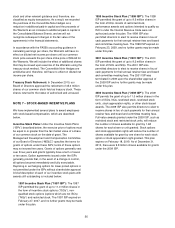Radio Shack 2010 Annual Report Download - page 58
Download and view the complete annual report
Please find page 58 of the 2010 Radio Shack annual report below. You can navigate through the pages in the report by either clicking on the pages listed below, or by using the keyword search tool below to find specific information within the annual report.48
Support Operations:
Our retail stores, along with our kiosks and dealer outlets,
are supported by an established infrastructure. Below are
the major components of this support structure.
Distribution Centers - At December 31, 2010, we had
four U.S. distribution centers shipping to our U.S. retail
locations and dealer outlets. One of these distribution
centers also serves as a fulfillment center for our online
customers. Additionally, we have a distribution center
that ships fixtures to our U.S. company-operated stores
and kiosks.
RadioShack Technology Services (“RSTS”) - Our
management information system architecture is
composed of a distributed, online network of
computers that links all stores, customer channels,
delivery locations, service centers, credit providers,
distribution facilities and our home office into a fully
integrated system. Each store has its own server to
support the point-of-sale (“POS”) system. The majority
of our U.S. company-operated stores and kiosks
communicate through a broadband network, which
provides efficient access to customer support data.
This design also allows store management to track
daily sales and inventory at the product or sales
associate level. RSTS provides the majority of our
programming and systems analysis needs.
RadioShack Global Sourcing (“RSGS”) - RSGS
serves our wide-ranging international import/export,
sourcing, evaluation, logistics and quality control
needs. RSGS’s activities support our name brand and
private brand businesses.
Consumer Electronics Manufacturing - We operate
two manufacturing facilities in the United States and
one in China. These three manufacturing facilities
employed approximately 1,800 people as of December
31, 2010. We manufacture a variety of products,
primarily sold through our retail outlets, including
telephones, antennas, wire and cable products, and a
variety of “hard-to-find” parts and accessories for
consumer electronics products.
NOTE 2 – SUMMARY OF SIGNIFICANT
ACCOUNTING POLICIES
Basis of Presentation: The consolidated financial
statements include the accounts of RadioShack
Corporation and all majority-owned domestic and foreign
subsidiaries. All intercompany accounts and transactions
are eliminated in consolidation.
Use of Estimates: The preparation of financial statements
in accordance with accounting principles generally
accepted in the United States requires us to make
estimates and assumptions that affect the reported
amounts of assets and liabilities, related revenues and
expenses, and the disclosure of gain and loss contingencies
at the date of the financial statements and during the periods
presented. We base these estimates on historical results and
various other assumptions believed to be reasonable, all of
which form the basis for making estimates concerning the
carrying values of assets and liabilities that are not readily
available from other sources. Actual results could differ
materially from those estimates.
Cash and Cash Equivalents: Cash on hand in stores,
deposits in banks and all highly liquid investments with a
maturity of three months or less at the time of purchase are
considered cash and cash equivalents. We carry our cash
equivalents at cost, which approximates fair value because
of the short maturity of the instruments. The weighted
average annualized interest rates were 0.4% and 0.3% at
December 31, 2010 and 2009, respectively, for cash
equivalents totaling $462.1 million and $820.5 million,
respectively. We maintain zero balance cash disbursement
accounts with certain banks. Outstanding checks in excess
of deposits with these banks totaled $49.1 million and $41.6
million at December 31, 2010 and 2009, respectively, and
are classified as accounts payable in the Consolidated
Balance Sheets. Changes in these overdraft amounts are
reported in the Consolidated Statements of Cash Flows as
a financing activity.
Accounts Receivable and Allowance for Doubtful
Accounts: Concentrations of credit risk with respect to
customer and dealer receivables are limited due to the
large number of customers, dealers and their location in
many different geographic areas of the country. We
establish an allowance for doubtful accounts based on
factors surrounding the credit risk of specific customers,
historical trends and other information. Historically, such
losses, in the aggregate, have not exceeded our
expectations. Account balances are charged against the
allowance when we believe it is probable that the
receivable will not be recovered. We have concentration of
credit risk from service providers in the wireless telephone
industry, primarily Sprint, AT&T, T-Mobile and Verizon. The
average payment term for these receivable balances is
approximately 45 days.
Inventories: Our inventories are stated at the lower of cost
(principally based on average cost, which approximates
FIFO) or market value and are comprised primarily of
finished goods. Included in the cost of the inventories are
in-bound freight expenses to our distribution centers, out-
bound freight expenses to our retail outlets, and other direct
costs relating to merchandise acquisition and distribution.
Also included in the cost of inventory are certain vendor
allowances that are not a reimbursement of specific,
incremental and identifiable costs to promote a vendor’s


